My Top 10 Classic Traveller Adventures (Part I)
Never let it be said that I don't give the audience what they want. That's why the latest in my year end Top 10 lists covers the adventures of Traveller. Like my previous lists, this one comes with a couple of notable caveats. The first is that this list only considers adventures published during the era of classic Traveller, which is to say, 1977–1986. The second is that the adventures in question must have been published as stand-alone products rather than as, say, articles in the pages of The Journal of the Travellers' Aid Society. The cuts down on the number of possible candidates, it's true, but there are still many possibilities to consider, especially since I'm taking into account licensees like FASA, Gamelords, and Judges Guild (spoiler alert: there are no JG adventures on this list).
I should also remind readers that, like previous lists of this sort, I have deliberately limited it to adventures I've personally refereed or played. That eliminates a handful of worthy contenders for inclusion, to be sure, but not so many that I think it undermines the utility of a list like this one. Still, if in your opinion there's an obvious omission, there's a good chance it's because I don't have any direct experience with the adventure in question.
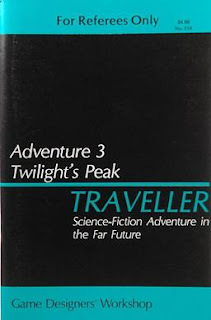 10. Twilight's Peak
10. Twilight's PeakTwilight's Peak is the third adventure ever published for Traveller and it's a very good one. Indeed, I hesitated to place it so low on the list, because, in some respects, it's a near perfect example of the kind of sober, serious science fiction that Traveller represented (especially in contrast to most other SF RPGs at the time). Unfortunately, the adventure depends heavily on the learning of certain information via rumors in order to proceed from world to world across the Spinward Marches. Even then, these rumors often only lead to the search for yet more information, potentially leading to a long and tedious investigation into matters whose ultimate import is not clear. Admittedly, the final payoff is worth it and the scenario includes a number of interesting stops along the way, but, unlike The Traveller Adventure – which is not included on this list, by virtue of its having been included elsewhere – I found it to lack forward momentum at times. Still, it's well-done and, as I said, a solid example of the kind of restrained science fiction Traveller does better than most SF RPGs before or since.
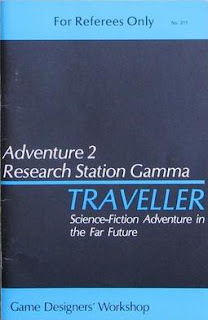 9. Research Station Gamma
9. Research Station GammaThis is the immediate predecessor to Twilight's Peak in terms of publication and deals with many of the same general concepts and themes, most specifically the mysterious, extinct alien species known only as the Ancients. Unlike Adventure 3, Research Station Gamma is more straightforward and therefore easier to use. On the downside, some of that straightforwardness comes in the form of being what is effectively a "dungeon crawl in space" – a common flaw in some of GDW's early Traveller adventures. The fact that much of the opposition in the scenario takes the form of alien animals held inside the titular research station only further contributes to this feeling. On the other hand, the "dungeon" in question is an interesting one, with an unusual architecture that many old Traveller hands look on with some fondness. The adventure is also notable for being one of the few GDW publications to mention, let alone describe, robots, an element of science fiction Traveller largely glossed over.
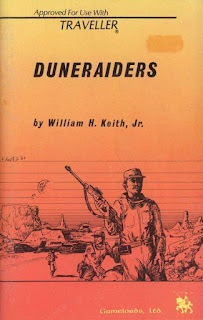 8. Duneraiders
8. DuneraidersPublished by Gamelords and written by William H. Keith, Duneraiders is a companion piece to the supplement, The Desert Environment (what a surprise!). The scenario itself deals with corporate warfare on the world of Tashrakaar, a mineral-rich planet located outside the borders of the Third Imperium. Tashrakaar has a native population, the so-called Duneraiders, who don't take kindly to the presence of offworlders and with whom the player characters must eventually ally – first simply to survive and later to thwart the machinations of the nefarious Dakaar Minerals corporation. If this all sounds more than a little inspired by Frank Herbert's famous novel series, you're not wrong. Fortunately, William H. Keith is a good adventure designer and he introduces enough new elements into the mix to ensure Tashrakaar isn't just a clone of Arrakis. I must confess to a lot of personal fondness for this adventure, because it's one of the few I first experienced as a player rather than as a referee. I had a lot of fun with it and that plays a role in its inclusion here.
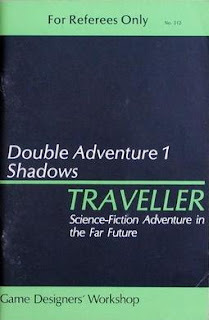 7. Shadows
7. ShadowsIn addition to its other adventures, GDW published a series of "double adventures," consisting of two shorter scenarios published back to back – and upside down – in imitation of the Ace Doubles released throughout the 1950s and '60s. Double Adventure 1 included an adventure entitled Shadows that is a favorite of mine, due in no small part that it was included in The Traveller Book as one of its sample scenarios (which is where I first encountered it). The adventure focuses on the discovery and exploration of a series of ancient alien pyramids on an inhospitable world. Though another example of a "dungeon crawl in space," Shadows pulls this off exceptionally well, with lots of interesting details and plenty of scope for characters to get into trouble. The pyramids are also a potential source of some remarkable information about their past – nothing earthshattering, mind you, but historically valuable. It's a great scenario with which to introduce newcomers to Traveller and its particular take on science fiction adventure.
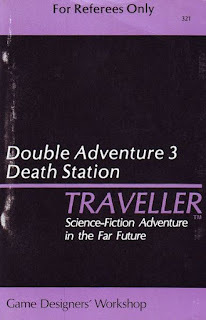 6. Death Station
6. Death StationYet another double adventure and yet another "dungeon in space." Death Station involves the player characters being hired to travel to an orbital laboratory ship with whom their patron has lost communications contact. While he suspects that the problem behind the loss of communications is merely technical in nature, it's possible that it's something more, which is why he outfits the characters appropriately. As presented, Death Station is fairly bare bones, focusing primarily on describing the lab ship in great detail, complete with maps and aids for the referee. However, the true nature of the problem – a psychochemical drug experiment gone wrong – opens up lots of possibilities for a frightening situation. Insane crewmen, escaped lab animals, and lots of hidden ducts and crawlspaces present the perfect environment for a tense handful of sessions. I used Death Station in my Riphaeus Sector campaign a few years ago to good effect.
James Maliszewski's Blog
- James Maliszewski's profile
- 3 followers



